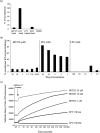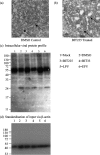Antiviral efficacy of the novel compound BIT225 against HIV-1 release from human macrophages
- PMID: 19995924
- PMCID: PMC2812169
- DOI: 10.1128/AAC.01308-09
Antiviral efficacy of the novel compound BIT225 against HIV-1 release from human macrophages
Abstract
Building on previous findings that amiloride analogues inhibit HIV-1 replication in monocyte-derived macrophages (MDM), Biotron Limited has generated a library of over 300 small-molecule compounds with significant improvements in anti-HIV-1 activity. Our lead compound, BIT225, blocks Vpu ion channel activity and also shows anti-HIV-1 activity, with a 50% effective concentration of 2.25+/-0.23 microM (mean+/-the standard error) and minimal in vitro toxicity (50% toxic concentration, 284 microM) in infected MDM, resulting in a selectivity index of 126. In this study, we define the antiretroviral efficacy of BIT225 activity in macrophages, which are important drug targets because cells of the monocyte lineage are key reservoirs of HIV-1, disseminating virus to the peripheral tissues as they differentiate into macrophages. In assays with acutely and chronically HIV-1Ba-L-infected MDM, BIT225 resulted in significant reductions in viral integration and virus release as measured by real-time PCR and a reverse transcriptase (RT) activity assay at various stages of monocyte-to-macrophage differentiation. Further, the TZM-bl assay showed that the de novo virus produced at low levels in the presence of BIT225 was less infectious than virus produced in the absence of the compound. No antiviral activity was observed in MDM chronically infected with HIV-2, which lacks Vpu, confirming our initial targeting of and screening against this viral protein. The activity of BIT225 is post-virus integration, with no direct effects on the HIV-1 enzymes RT and protease. The findings of this study suggest that BIT225 is a late-phase inhibitor of the viral life cycle, targeting Vpu, and is a drug capable of significantly inhibiting HIV-1 release from both acute and chronically infected macrophages.
Figures





Similar articles
-
The antiviral compound BIT225 inhibits HIV-1 replication in myeloid dendritic cells.AIDS Res Ther. 2016 Feb 8;13:7. doi: 10.1186/s12981-016-0093-z. eCollection 2016. AIDS Res Ther. 2016. PMID: 26858771 Free PMC article.
-
The HIV-1 Vpu viroporin inhibitor BIT225 does not affect Vpu-mediated tetherin antagonism.PLoS One. 2011;6(11):e27660. doi: 10.1371/journal.pone.0027660. Epub 2011 Nov 14. PLoS One. 2011. PMID: 22110710 Free PMC article.
-
A Phase 1b/2a study of the safety, pharmacokinetics and antiviral activity of BIT225 in patients with HIV-1 infection.J Antimicrob Chemother. 2016 Mar;71(3):731-8. doi: 10.1093/jac/dkv389. Epub 2015 Nov 29. J Antimicrob Chemother. 2016. PMID: 26620101 Clinical Trial.
-
Mechanisms underlying of antiretroviral drugs in different cellular reservoirs with a focus on macrophages.Virulence. 2020 Dec;11(1):400-413. doi: 10.1080/21505594.2020.1760443. Virulence. 2020. PMID: 32375558 Free PMC article. Review.
-
Antiviral profile of HIV inhibitors in macrophages: implications for therapy.Curr Top Med Chem. 2004;4(9):1009-15. doi: 10.2174/1568026043388565. Curr Top Med Chem. 2004. PMID: 15134554 Review.
Cited by
-
Tetherin and its viral antagonists.J Neuroimmune Pharmacol. 2011 Jun;6(2):188-201. doi: 10.1007/s11481-010-9256-1. Epub 2011 Jan 11. J Neuroimmune Pharmacol. 2011. PMID: 21222046 Free PMC article. Review.
-
Bacteria-based analysis of HIV-1 Vpu channel activity.PLoS One. 2014 Oct 1;9(10):e105387. doi: 10.1371/journal.pone.0105387. eCollection 2014. PLoS One. 2014. PMID: 25272035 Free PMC article.
-
A small molecule compound IMB-LA inhibits HIV-1 infection by preventing viral Vpu from antagonizing the host restriction factor BST-2.Sci Rep. 2015 Dec 16;5:18499. doi: 10.1038/srep18499. Sci Rep. 2015. PMID: 26669976 Free PMC article.
-
Advances in Viroporin Function and Structure: A Comparative Analysis of Alphavirus 6K with Well-Characterized Viroporins.Viruses. 2025 Jun 19;17(6):868. doi: 10.3390/v17060868. Viruses. 2025. PMID: 40573459 Free PMC article. Review.
-
Mechanism of function of viral channel proteins and implications for drug development.Int Rev Cell Mol Biol. 2012;294:259-321. doi: 10.1016/B978-0-12-394305-7.00006-9. Int Rev Cell Mol Biol. 2012. PMID: 22364876 Free PMC article. Review.
References
-
- Aquaro, S., P. Bagnarelli, T. Guenci, A. De Luca, M. Clementi, E. Balestra, R. Caliò, and C. F. Perno. 2002. Long-term survival and virus production in human primary macrophages infected by human immunodeficiency virus. J. Med. Virol. 68:479-488. - PubMed
-
- Aquaro, S., E. Balestra, A. Cenci, M. Francesconi, R. Caliò, and C. F. Perno. 1997. HIV infection in macrophage: role of long-lived cells and related therapeutical strategies. J. Biol. Regul. Homeost. Agents 11:69-73. - PubMed
-
- Aquaro, S., R. Caliò, J. Balzarini, M. C. Bellocchi, E. Garaci, and C. F. Perno. 2002. Macrophages and HIV infection: therapeutical approaches toward this strategic virus reservoir. Antiviral Res. 55:209-225. - PubMed
-
- Balliet, J. W., D. L. Kolson, G. Eiger, F. M. Kim, K. A. McGann, A. Srinivasan, and R. Collman. 1994. Distinct effects in primary macrophages and lymphocytes of the human immunodeficiency virus type 1 accessory genes vpr, vpu, and nef: mutational analysis of a primary HIV-1 isolate. Virology 200:623-631. - PubMed
-
- Binette, J., and E. A. Cohen. 2004. Recent advances in the understanding of HIV-1 Vpu accessory protein functions. Curr. Drug Targets Immune Endocr. Metabol. Disord. 4:297-307. - PubMed
MeSH terms
Substances
LinkOut - more resources
Full Text Sources
Other Literature Sources
Medical

